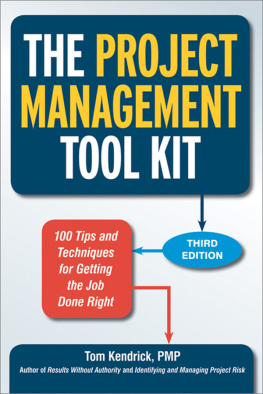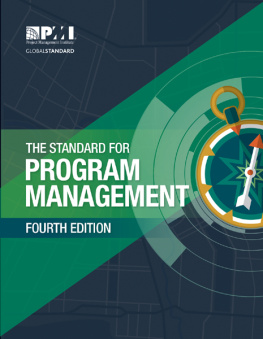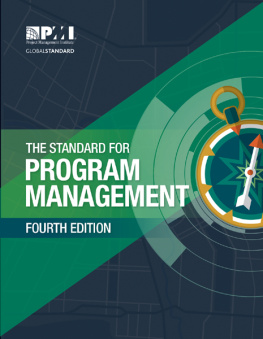Thank you for downloading this AMACOM eBook.
Sign up for our newsletter, AMACOM BookAlert , and receive special offers, access to free chapter downloads, and info on the latest new releases from AMACOM, the book publishing division of American Management Association.
To sign up, visit our website: www.amacombooks.org

ADVANCE PRAISE FOR
HOW TO MANAGE COMPLEX PROGRAMS
This book offers a wealth of advice on program management, describing how to scale up project management for large endeavors and avoid common pitfalls along the way.
Rhonda Hostetler, PMP, Project Manager,
UC Berkeley Energy Biosciences Institute
At long last we have a definitive work on program management. How to Manage Complex Programs brings together a comprehensive view of programs and how to manage them. Tom Kendrick has added new research and insights to the fundamental knowledge about managing complexity in the project/program arena. His insights and powerful examples provide learning that can be applied immediately to even the most complex program. Kendricks style is easy and enjoyable to read. How to Manage features nuggets for very experienced program managers and an excellent approach for those new to managing complexity. This is one of those books I have needed in my own attempts at managing complex programs. This book will become a prominent and oft used part of my project management bookshelf, and it should be required reading for anyone asked to manage a complex program or project.
Patrick Neal, Ph.D., PMP, Principal Consultant,
Project Synergistics
I was particularly impressed by the emphasis in Tom Kendricks book on program strategy alignment and on pragmatic decision-making. He not only clearly describes program management challenges throughout the book, but he offers the reader effective guidance for dealing with them.
Frances C. Bellows, J.D., PMP,
Strategy Implementation
and Planning Consultant
HOW TO MANAGE
COMPLEX
PROGRAMS
HOW TO MANAGE
COMPLEX
PROGRAMS
High-Impact Techniques for Handling Project
Workflow, Deliverables, and Teams
TOM KENDRICK

CONTENTS
by Tom Kendrick, PMP
ACKNOWLEDGMENTS
This book is the result of many classes, workshops, discussions, debates, personal experiences, and much more. I am deeply grateful to many friends with whom I have interacted and worked over the years. There are far too many to name, but a partial list includes Elie Asmar, James T. Brown, Ray Ju, Virginia Greiman, Takeo Kimura, Chuck Bosler, Craig Peterson, Esteri Hinman, and many colleagues from in and around Hewlett-Packard such as Terry Ash, Wolfgang Blickle, Ted Slater, Swen Conrad, Tom MacDonald, Lou Combe, Cedric Bru, Art Greenberg, John Lambert, Peter Bruce, Chris Briggs, Martin Smith, Garry Gray, Charlie Elman, Patrick Neal, Randy Englund, Richard Bauhaus, Richard Simonds, Scott Beth, Kathy Meikle, Denis Lambert, Ron Benton, Rick Ellis, Cathy Tonne, and Bill Seidman.
I am particularly grateful to all the patient managers who provided the most valuable crucible for learning, the opportunity to strive on following mistakes, stumbles, and problemswhich are all inevitable on large programsto discover what works and ultimately to succeed.
While others have contributed enormously to the content of this book, all errors, omissions, or other problems are strictly my own. Should you find any, please let me know.
INTRODUCTION
Programs are complexoften extremely complexcollections of projects. Successful program management begins with a good command of project management processes, but that is never sufficient. Once a project exceeds a certain scale, project processes become unwieldy. To make the methods of project management effective for major programs, the work must be broken down and organized into a set of interdependent undertakings that can be autonomously executed. Program management challenges include dealing with complex hierarchies in three main domains: deliverables, workflow, and staffing.
System deliverables require up-front analysis to decompose them into a hierarchy of understandable components. Successfully developing complex systems requires that each part be sufficiently independent to permit parallel development, with the interconnections to other components sufficiently defined to warrant confidence that they can be successfully integrated and function as expected.
Major programs involve thousands (or many thousands) of activities, overwhelming the basic project planning techniques. Developing practical, effective schedules for the work begins with decomposing program work (often along similar boundaries as the component deliverables) to limit what each project plan must contend with. This process involves trade-offs and a goal of minimizing the number of linkages and handoffs where workflow transitions between the related projects.
Program management also requires developing an organizational chart hierarchy for staff, ensuring that it is clear where each high-performing project team fits in a large community of contributors. Developing an appropriate layered structure for programs involving multiple distributed (often global) teams and project leaders can be challenging. Leadership, including use of effective program management office (PMO) techniques, is essential for motivating and coordinating the large staffs required by major programs.
This book focuses on the processes required to effectively manage programs. What follows assumes a knowledge of the fundamentals for managing projects effectively. The book does not focus on or prescribe any particular project methodology or processes, but rather shows how to build on effective project-level practices. Good program management need not rely on a specific approach for handling projects, but it does require that processes that work well are in place and consistently (and competently) applied. Project planning techniques may range from practices such as Scrum for agile undertakings to network critical path analysis for conventional projects, but effective program management always relies on some consistent, effective means for understanding the projects that constitute a program. Other necessary project management practices include project risk analysis and management, application of software tools, and other basic techniques.
This book also assumes that the organization has well-established, functioning life cycles or iteration standards, clearly defined project metrics that are accepted and routinely used, and an analysis-based procedure for managing a portfolio of projects and programs. To thrive, the principles of effective program management require a firm organizational foundation to take care of both project details and the overall context. This book describes, using examples, how program management extends and builds on project management methods, and it explains techniques for organizing and controlling large, complex undertakings.
PMI (THE PROJECT MANAGEMENT INSTITUTE)
PMI and the PMI logo are service and trademarks of the Project Management Institute, Inc., which are registered in the United States of America and other nations; PMP and the PMP logo are certification marks of the Project Management Institute, Inc., which are registered in the United States of America and other nations; PMBOK,
Next page









